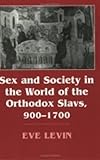Sex and Society in the World of the Orthodox Slavs 900–1700 / Eve Levin.
Material type: TextPublisher: Ithaca, NY : Cornell University Press, [2018]Copyright date: ©1995Description: 1 online resource (344 p.) : 15 halftonesContent type:
TextPublisher: Ithaca, NY : Cornell University Press, [2018]Copyright date: ©1995Description: 1 online resource (344 p.) : 15 halftonesContent type: - 9781501727627
- Orthodox Eastern Church members -- Sexual behavior -- Europe, Eastern -- History
- Orthodox Eastern Church members
- Sex customs -- Europe, Eastern -- History
- Sex -- Religious aspects -- Orthodox Eastern Church -- History
- Slavs -- Sexual behavior -- History
- History
- Soviet & East European History
- HISTORY / Medieval
- 306.7/0947 19
- HQ18.E852
- online - DeGruyter
| Item type | Current library | Call number | URL | Status | Notes | Barcode | |
|---|---|---|---|---|---|---|---|
 eBook
eBook
|
Biblioteca "Angelicum" Pont. Univ. S.Tommaso d'Aquino Nuvola online | online - DeGruyter (Browse shelf(Opens below)) | Online access | Not for loan (Accesso limitato) | Accesso per gli utenti autorizzati / Access for authorized users | (dgr)9781501727627 |
Frontmatter -- Contents -- Illustrations -- Preface -- Abbreviations -- Introduction -- Chapter 1. The Ecclesiastical Image of Sexuality -- Chapter 2. Marriage -- Chapter 3. Incest -- Chapter 4. Illicit Sex -- Chapter 5. Rape -- Chapter 6. Sex and the Clergy -- Conclusion -- Bibliography -- Index
restricted access online access with authorization star
http://purl.org/coar/access_right/c_16ec
In this pioneering book, Eve Levin explores sexual behavior among the peoples of Serbia, Bulgaria, and Russia from their conversion to Christianity in the ninth and tenth centuries until the end of the seventeenth century. By ranging across all these societies, Levin is able to fulfill three basic aims: to delineate the general character of sexuality among the Orthodox Slavs, to enrich that account by drawing our attention to regional variations in the sexual mores of these peoples, and to draw suggestive comparisons between the world of the medieval Orthodox Slavs and their contemporaries in the Latin West.Levin begins with a study of the ecclesiastical image of sexuality as expressed in didactic and literary texts, showing that the Orthodox Church was deeply suspicious of sexuality. Her second chapter, on canon law and marfiage, examines the conditions for marriage, divorce, and remarriage, the obligation of the conjugal relationship, and the impact of these rules on social order. Levin looks at church regulations concerning sexual relations among relatives by blood, marriage, spiritual kinship, and adoption in Chapter Three, and she devotes Chapter Four to prohibited sexual practices, both inside and outside of marriage. In the fifth chapter she studies Russian and South Slavic responses to rape, and demonstrates that these societies simultaneously censured violence against women and sanctioned the attitudes and social structures that justified it. Chapter Six deals with the rules on sexual conduct for the clergy, whose job it was to enforce sexual precepts. Throughout her work, Levin argues that, despite its conviction that sexual expression was diabolical, the medieval Orthodox Church approached sexual matters in a surprisingly practical way; its official sexual ethic corresponded to a great degree with popular views.Historians of the Slavic world, both medieval and modern, will welcome this accessible study. It should also attract comparativists who work in such fields as church history, the history of women and the family, and the history of sexuality.
Mode of access: Internet via World Wide Web.
In English.
Description based on online resource; title from PDF title page (publisher's Web site, viewed 26. Apr 2024)


